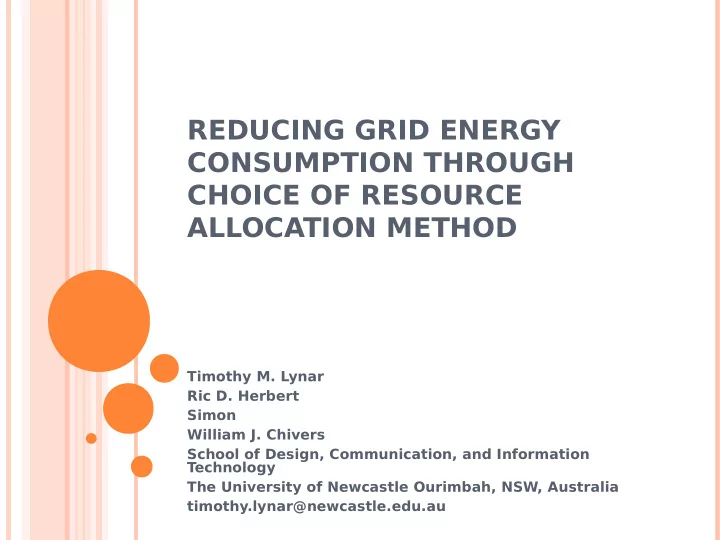

REDUCING GRID ENERGY CONSUMPTION THROUGH CHOICE OF RESOURCE ALLOCATION METHOD Timothy M. Lynar Ric D. Herbert Simon William J. Chivers School of Design, Communication, and Information Technology The University of Newcastle Ourimbah, NSW, Australia timothy.lynar@newcastle.edu.au
INTRODUCTION Introduction Background Resource allocation What we are doing Description Results Analysis Concluding remarks Future work
INTRODUCTION This research looks at: The use of simple auctions Allocating resources in grids and clusters Pilot environment Scale up to a Grid Environment
BACKGROUND Energy saving in Grid computing Uncoordinated methods Voltage and frequency scaling (VFS) Dynamic voltage and frequency scaling (DVFS) Dynamic power management (DPM) Coordinated methods Unbalancing Coordinated VFS Variable on / Variable off (VOVO)
BACKGROUND – RESOURCE ALLOCATION There has been substantial recent work on conserving energy in grid computing through resource allocation including: Heterogeneous nature of geographically dispersed data centers (Patel et al.; Shah and Krishnan) Game theoretical approach to power-aware resource packing (Zomaya et al.)
BACKGROUND – AUCTIONS Historically auctions have been used to allocate resources There are many auctions in use today including English auction (First price ascending) Dutch auction (First price descending) Continuous double auction Vickrey auction (Second price, sealed bid)
GRID RESOURCE ALLOCATION What do we mean by Grid? Multi-institutional Cluster of clusters What type of application? Computationally intensive / low data Prime number search
WHAT WE ARE DOING Using conventional economic resource allocation mechanisms (auctions) to reduce energy consumption. Different auctions have different attributes relating to speed and efficiency of allocation. We are looking at the efficiency of the allocations in relation to the conservation of grid energy over a variety of workflows.
DESCRIPTION OF RESOURCE ALLOCATION MECHANISMS Batch auction Continuous random allocation (CRA) Pre processed Batch auction (PPBA)
DESCRIPTION OF RESOURCE ALLOCATION MECHANISMS - BATCH The batch auction Requests to resources that they provide a bid, Waits until resources respond, Sorts the resources based on their bid Assigns incoming tasks to resources Will always allocate to the most efficient available resource Note: All bids are based on the node’s power/performance ratio.
DESCRIPTION OF RESOURCE ALLOCATION MECHANISMS - CRA Allocates to first available node Cannot guarantee efficiency Will allocate quickly
DESCRIPTION OF RESOURCE ALLOCATION MECHANISMS - PPBA Stores history Allocates on historical data, then asks.
RESEARCH QUESTION Will altering the resource allocation mechanism affect the allocation of resources in a way that alters the total energy used in the execution of tasks? (In this paper we did not discuss execution time due to space constraints)
EXPERIMENT DESIGN AND APPROACH Three (3) workflows First on a pilot environment Then on a small grid The workflows consist of known tasks, to ensure repeatability T asks are allocated interactively
LIMITATIONS We have attempted to limit the impact of external forces on our experiments and as such: We have exclusive access to the resources The tasks are all homogenous The software setup of each node is identical We also assume: Nodes cannot be switched off or to a low power state Accounting of energy starts from the submission of the first task to the first node until the completion of the last task.
THE TASK A modified prime number search script Represents processor intensive but data light tasks
WORKFLOWS Workflow 1 consists of 100 small tasks Workflow 2, 100 medium tasks Workflow 3, 50 large tasks In each workflow the tasks are submitted at equal intervals over a period of ten minutes
PILOT ENVIRONMENT
GRID ENVIRONMENT Note: the clusters within the grid are of different sizes and vintage.
RESULTS - PILOT Note: each test was performed ten (10) times; the values above are means
RESULTS - GRID
ANALYSIS OF RESULTS - PILOT In workflow one There was a significant difference in energy consumption CRA and PPBA CRA and batch No significant difference between batch and the PPBA
ANALYSIS OF RESULTS – PILOT Workflow one Small tasks CRA uses the least energy
ANALYSIS OF RESULTS – PILOT In workflow two there was a significant difference in the energy used by each pair of mechanisms. In workflow three there was significant difference between the CRA and batch mechanisms, and between the CRA and PPBA mechanisms, but not between the batch and PPBA mechanisms. Workflow two Workflow three
ANALYSIS OF RESULTS - GRID In workflow one there was a significant difference in the energy consumption depending on the resource allocation mechanism chosen. The PPBA and batch mechanisms were not significantly different from each other. There were significant differences between the CRA and batch mechanisms and between the CRA and PPBA.
ANALYSIS OF RESULTS - GRID In workflow two the only significant difference in energy consumption was between the CRA and batch mechanisms.
ANALYSIS OF RESULTS - GRID In workflow three the CRA was significantly different from both the batch and the PPBA which were not significantly different from each other. However, the energy difference suggests that PPBA might be performing better than batch when processing this workflow, more tests are needed.
ANALYSIS OF RESULTS The results of the pilot and grid studies were similar The grid results showed more variance Greater number of nodes External factors Minor heterogeneity of homogeneous nodes Latency
ANALYSIS OF RESULTS Why did the CRA auction outperform the others in workflow one? The tasks finished in a fraction of a second on any node The master node (node of submission)
CONCLUDING REMARKS These results reveal that altering the resource allocation mechanism can significantly alter the energy used in the execution of tasks. The results show that the differing characteristics of these simple auctions may be useful in the conservation of energy.
FUTURE WORK Simulate a number of different auctions Under what circumstances one auction perform better than another auction.
ANY QUESTIONS?
Recommend
More recommend